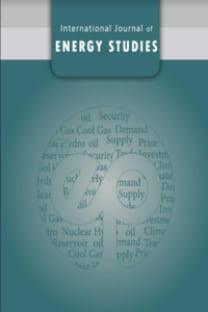Alternative heat insulation method for rigid construction walls
heat insulation, Heat Transfer, Thermal Conductivity,
___
- Yapı Endüstri Merkezi, “Türk yapı sektörü raporu 2006”, Güzel Sanatlar Matbaası 2006: 1-26.
- Gürbağ, H., “Sanayide yalıtıma ekonomik açıdan bakış”, Isı Bilimi ve Tekniği Dergisi 1987: 10; 11.
- Campanale, M., Moro, L. “Thermal conductivity of moist autoclaved aerated concrete: experimental comparison between heat flow method (HFM) and transient plane source technique (TPS)”, Transp. Porous Media 2016: 113; 345–355.
- Özer, N., “Atıklardan üretilen ısı yalıtım malzemelerinin yaygın kullanılan ısı yalıtım malzemeleri ile karşılaştırılması”, MSc Thesis, Istanbul Technical University, 2017.
- Woloszyn, M., Kalamees, T., Abadie, M.O., Steeman, M., Kalagasidis, S.A. “The effect of combining a relative-humidity-sensitive ventilation system with the moisture-buffering capacity of materials on indoor climate and energy efficiency of buildings”, Building Environ. 2009: 44; 515–524.
- Shea, A., Wall, K., Walker, P. “Evaluation of the thermal performance of an innovative pre-fabricated natural plant fibre building system”, Build. Serv. Eng. Res. Technol. 2013: 34(4); 369-380.
- Zach, J., Korjenic, A., Petranek, V., Hroudova, J., Bednar, T. “Performance evaluation and Research of alternative thermal insulations based on sheep wool”, Energy and Buildings 2012: 49; 246-253.
- Korjenic, A., Petranek, V., Zach, J., Hroudova, J. “Development and performance evaluation of natural thermal-insulation materials composed of renewable resource”, Energy Build. 2011: 43; 2518–2523.
- Charca, S., Noel, J., Andia, D., Flores, J., Guzman, A., Renteros, C., Tumialan, J. “Assessment of ichu fibres as non-expensive thermal insulation system for the Andean regions”, Energy Build. 2015: 108; 55-60.
- Wei, K., Lv, C., Chen, M., Zhou, X., Dai, Z., Shen, D. “Development and performance evaluation of a new thermal insulation material from rice straw using high frequency hot-pressing”, Energy Build. 2015: 87; 116-122.
- Deque, F., Ollivier, F., Roux, J.J. “Effect of 2D modelling of thermal bridges on the energy performance of buildings”, Energy and Buildings 2001: 33; 583-587.
- Yayın Aralığı: Yılda 4 Sayı
- Başlangıç: 2016
- Yayıncı: Türkiye Enerji Stratejileri ve Politikaları Araştırma Merkezi (TESPAM)
The Model of “Free Investment & Centralised Management” in Renewable Energy Production Projects
Selman DEMİRKESEN, Halil VARİYENLİ
Bahadir ACAR, Abdullah DAĞDEVİREN, Ahmed JANAANİ, Khandan ROSHANAEI, Edip TAŞKESEN, Göknur KAYATAŞ ONGUN, Mehmet ÖZKAYMAK
Selman DEMİRKESEN, Halil VARİYENLİ
